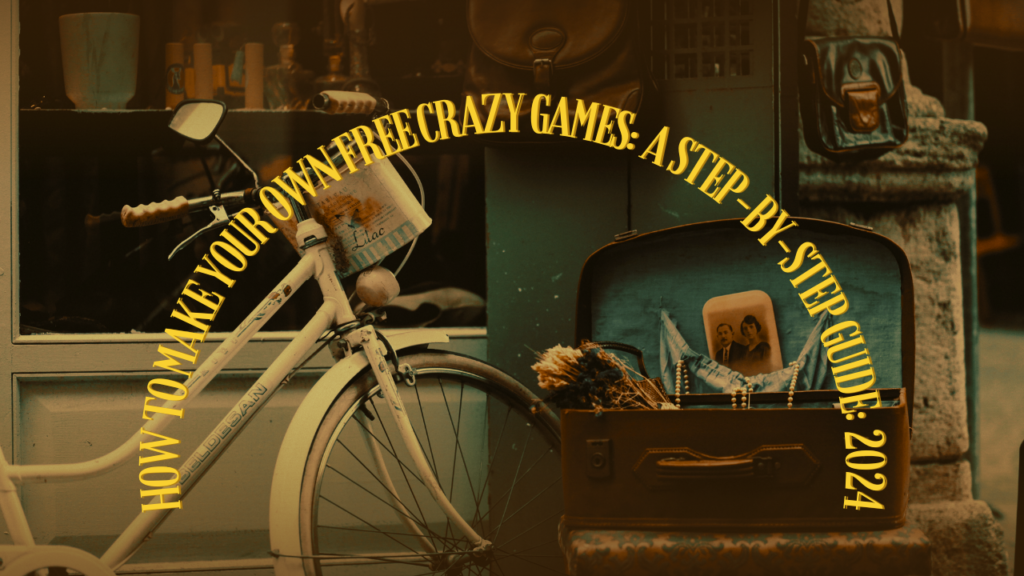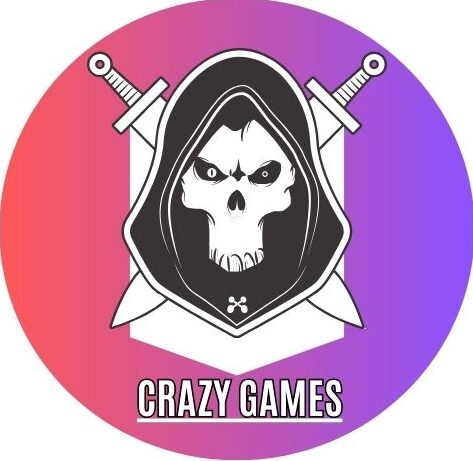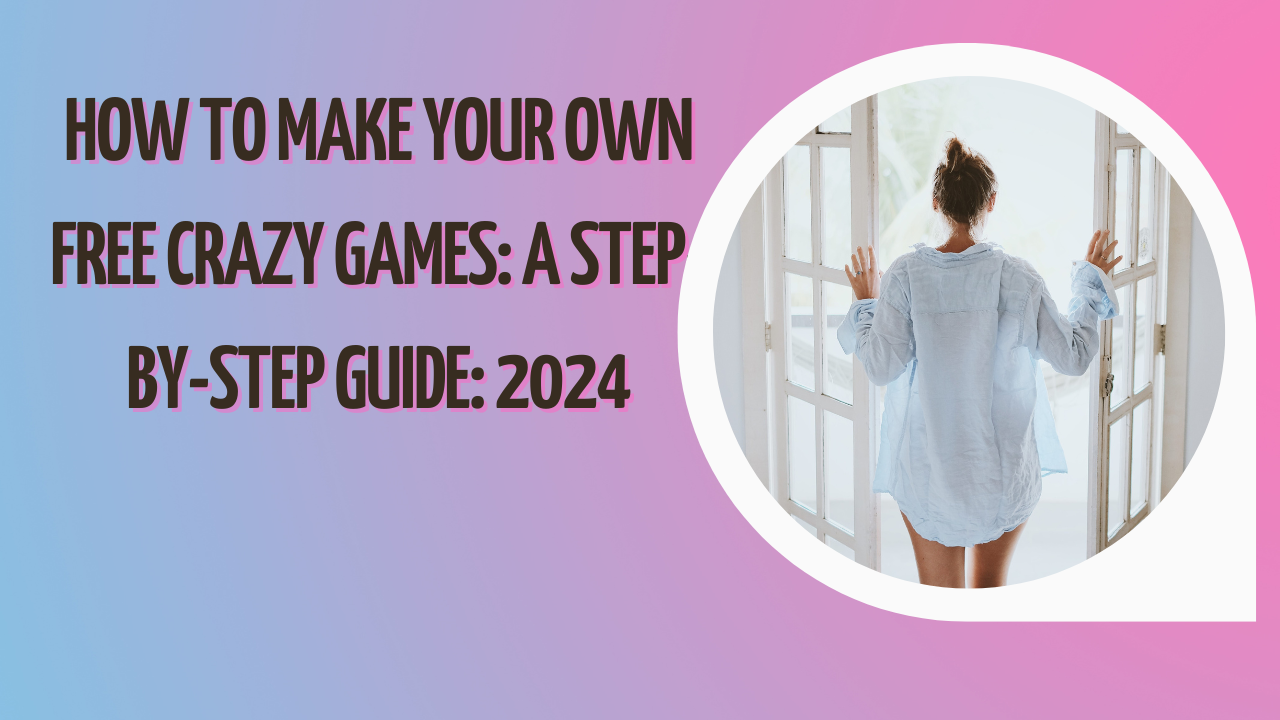Table of Contents
Introduction
The world of gaming is amazing and ever-changing in the number of possibilities. Many do believe that creating a game is for massive studios with huge budgets, but the truth is the fact that people can start making their own games today-yet many times for free! All thanks to super-friendly game development tools and a variety of resources, you can today create your crazy game right from your home-and not because you have knowledge about programming.
We’ll take you through making your own crazy games from scratch, covering speedy, arcade-focused games all the way through wacky puzzles and just plain weird game designs. Whatever you’re fancy is, we take you through the tools, techniques, and tips that will bring your ideas to life.

Appeal of Creating Your Own Crazy Games
Okay, so let’s start by understanding why creating your own game could be so rewarding as an endeavor.
For me, the journey of game development started as a way to combine creativity and technology. The thrill of designing a virtual world, seeing characters come to life, and watching others play something you’ve built is incredibly satisfying. It’s a fantastic way to express your creativity, challenge yourself with new skills, and even share your work with others—whether for fun, profit, or both.
Indeed, the gaming industry has grown to the point where most of the independent game developers around the world are now noticed and recognized. Titles like “Stardew Valley” and “Undertake” were the products of a solo developer or a small team. Accessibility of game development tools enabled so many people to enter the world of games. And who knows? Maybe your own crazy game could be the next viral hit!
Step 1: Understanding the Basics of Game Development
Before jumping into creating a game, it’s essential to understand the core aspects of game development. It involves multiple elements, from game design and mechanics to graphics and sound.
These are some of the fundamental steps you’ll need to consider:
1. Game Design
You will need a game idea first. What kind of game would you want to make?
Imagine fast-paced like an action game or relaxing, story-driven adventure. Think about your target audience and what they would enjoy.
Brainstorm outside the box to come up with a really wacky game. You may even want to create a game where the players are an alien stunt rider or some kind of unusual racing game where the player rides a unicycle and has to avoid everything in his or her way. Brainstorming might help ‘feel’ of the game by making a mind map or mood board
2. Game Mechanics
These are the rules of how your game will work. Is it going to be a plat former, puzzle game, endless runner?
Do the players collect items, defeat enemies, or solve problems in order to advance? These have to add on to your concept and what story you want to tell.
3. Art and Design
A pretty game will capture the imagination of the people. For your wild game, you are most likely going to need bright, cartoon-like visuals. You don’t necessarily need to hire a graphic designer. You can use free assets available online and just modify them for your purposes. You can even go ahead and make your own if you want to. There’s loads of beginner-friendly stuff out there that’ll make simple 2D or 3D models.
4. Sound
Audio and music will add depth and excitement to your game. A crazy, fast-paced soundtrack or quirky sound effects will make the atmosphere of your game much better. There are so many free sound libraries that you can download or even create your own using online tools.
5. Coding
This is where most new game developers get intimidated, but don’t worry! There are many free platforms that make programming as easy as possible, even for a rookie. Unity, Go dot, or Construct game engines have user-friendly visual scripting tools, which let you create games without ever having to manually type code. However, if you want to get further into the land of programming, it’ll be very useful to learn some languages, like C# for Unity, and Adscript for Go dot.
Step 2: Game Development Platforms to Get Started With
Here are many free game development platforms that you can make use of your own wild games. Among these, for beginners are:
1. Scratch
Scratch is absolutely free of charges and highly new-user friendly, which allows for creating 2D games within visual programming language. It is great for newcomers. The drag-and-drop interface lets you easily create interesting games and animations. Scratch is great for younger developers or even those who just want to look closer at the game design.
2. Unity
One of the most widely used game development engines, Unity is ideal for both new developers and professional developers. Small games are free, and millions of users have already made tutorials that helped. It’s really fantastic for making 2D and 3D games and has much flexibility. But it’s hard to understand if compared with Scratch, though learners can learn from much learning material.
3. Go dot
Go dot is another free game engine which is gaining more attention from the indie game developer community. This open-source platform specializes in 2D games and with the help of the default language, GDScript, learning becomes simple, even for new players. It’s also famous for being light on the computer while still making fast-paced crazy games with one-of-a-kind mechanics.
4. Construct
Construct is a game engine that focuses more on creating 2D games. It uses drag and drops so no need for coding, thus suitable for those who wish to develop their game in the shortest period. You would want to develop such a nutty game, full of odd mechanisms or comical characters but do not have a clue as regards coding experience. Construct suits you perfectly.
Step 3: Your crazy game
Now that you have your game design concept and the platform on which you will play, it is very high time to start making that crazy game of yours. The following is how you will break the process into steps:
1. Building basic mechanics
First, get your core game play mechanics, so if it is a jumping game, focus getting jumping functionality right. If it is a racing game, focus on inputting the movement and controls first, then you can detail further.
2. Get your characters and what’s inside your environment
Create your game world by using your favorite game engine. Design your characters and environments, be it a jungle or a space station or underwater world. You can use free assets or create simple ones using basic shapes since you may not have access to a designer.
3. Add Crazy Features
This is where your game gets wild. You can introduce crazy, wild elements. For example, the players are flying now, and the world just keeps changing. There can be weird enemies too that throw in some surprises: for example, gravity is a countdown. You get the drift of what could make your game exciting, fun, and unpredictable.
4. Playtest and Refine
Play test is vital. You have just created your first version of the game so play it a few times to test it properly. Ask your friends or family to try it and give you feedback on how it plays and whether they enjoy playing it. With that information, you’ll adjust it appropriately and refine your game.
Publishing and Sharing Your Crazy Game

Step 4
Once you design your game, you publish it to the world. Most gaming platforms allow free publishing of one’s games in which other gamers can play your game.
1. Itch.io
It is one of the popular websites for independent game developers. You can upload and share your games free of charge or for whatever price you set. It is a good place to show off experimental or crazy games and get feedback from the players.
2. Game Jolt
Game Jolt is another site that offers free hosting of indie games. Similarly to Itch.io, it offers a wonderful community which will love to share new indie games and to have fun playing them. Game Jolt also has its social interaction feature in terms of allowing developers to connect to other developers.
3. Newgrounds
It’s become the oldest platform for indie games and animations. It’s a great place to share your game and get noticed by an audience that thrives upon the creativity and out-of-box thoughtfulness. And it’s absolutely free!
4. Social Media
Once you upload your game, share it with friends and fellow developers on social media platforms, like Twitter, Reddit, or Facebook. Something in your game that no other game has may attract a niche audience who love it.
Step 5: Additional Tips on How to Make Crazy Games Engaging and Fun
While making a game weirder than your craziest dreams, do not forget the involvement and enjoyment of the player. It is too easy to get lost in the process of development because one forgets to focus on producing the game entertaining and fun for players. Here are a few extra tips to remember:
1. Add Unpredictable Elements
Unpredictability is the hallmark of an insane game, such as sudden reversals in gravitation or spontaneous obstacles. Maybe unusual character talents might ensure that the game does not sound too mundane or repetitive in nature. Random events or dynamic levels can help balance the expectations while serving an exciting experience to the gamer.
Example: A sudden change in environment, such as in an adrenaline racing game, can make your racing track a maze one moment and have you interacting with your enemies the next.
2. Invent Interesting Power-Ups
Power-ups are an amazing way to infuse fun and excitement in your game. Think of how weird and outrageous the power-ups are when placed into the game to reflect its nutty theme, like temporary invincibility or some wild time-warped effect. The thing about power-ups is that, not only will they spice up gameplay but they also inspire gamers to try a few things around.
Example: For example, in a platformer you can have a “Super Bounce” power-up that lets the character bounce off walls or temporarily defy gravity.
3. Add Fun Easter Eggs
Easter eggs are those features or messages in the game that the players will find. Little surprises like these keep them playing because they enjoy finding secrets or rewards that are hidden. You add Easter eggs to your crazy game so that players will have more to explore and will appreciate the extra effort you have put into the game.
Example: Some cool Easter eggs hidden behind secret doors or even weird skins for characters can make your game more fun.
4. Gameplay Flows Well
A completely absurd game must never compromise on slick gameplay to arrive. A properly mad game would never let a gamer feel out of control as much as possible. Game play may get ridiculously frustrating if too difficult to control, or worse, unresponsive. Testing the game mechanics frequently keeps the game play exciting and running.
Example: The control action should feel responsive and fluid. A game where things spiral out of control quickly defeats the whole point of having fun.
5. Developing a Story or Theme
Often, games stand out because of memorable characters or out-of-the-box themes. While your game might be full of wild action, giving it a quirky story or narrative makes it deep. Make the storyline of your game humorous or absurd; this makes it relatable and immersive to players.
For example, a game can be created around a topic of penguins who have to break the challenge of time in order to steal ice cream from some evil villain. What makes the game even funny is its storyline.
Step 6: Basic Blunders Which One Should Avoid While Creating the Nonsensical Games
Game development often turns out to be a fun and rewarding adventure. Mistakes are easy, however. Here are some pitfalls that developers – especially beginners – often fall into. They’ll help you avoid the pitfalls that keep you on a track toward more successful games.
1. Overcomplicating the Design
It’s tempting to throw in as many crazy features and ideas as possible but be careful not to overwhelm the player. Too many mechanics or too intricately complex game play can frustrate frustration. Start with a simple core gameplay loop and build on it gradually, making sure that each addition enhances the game rather than complicating it.
Tip: Do make some central mechanics super fun, and do not pile in too much on features.
2. Underestimating the UI Design
Even crazies deserve usable and intuitive UI. A messy or confusing UI aggravates players, usually while navigating the menus or figuring out how to play. Try keeping it simple, readable, and consistent throughout the game.
Tip: Make sure the player knows how to access critical functions such as pausing the game, changing settings, or checking objectives.
3. Skipping Playtesting
The biggest mistake that can be made by any game developer is skipping the play testing phase. This is really what marks the difference between a game that will reach the public and one that won’t; playtesting will help you catch and correct problems before it hits the public.
Tip: Many times, test your game, and make it play for someone else so that you catch the problems you might have looked over.
4. Ignore Performance Optimization

That would be a crazy game to play emphasizing more creativity and fun, but a game does not necessarily have to forget its performances. A game whose loading times are slow and at some point crashes or produces terrible graphics will frustrate any player no matter the game. Optimize your game performance so it smoothes across different devices.
Tip: Test your game on all sorts of devices to optimize your assets – graphics, code, and so on.
5. Lack of clear instructions
Some may produce something that is so unique, but wild mechanics, on the other hand, through which players create, may call for much explanation. So imagine not a thing of such a nature: instead, let instruct players-detailed instructions-through the tutorials just like an in-game message prompt might help explain games a little better while at it, letting games remain experiences in themselves.
Tip: Include a tutorial or at least pop-up hints in the first few minutes of gameplay to familiarize players with controls and objectives.
Step 7: Marketing and Promoting Your Crazy Game
Once you develop your wacky game and feel that it’s already time to share it with the world, the game needs marketing. Even if you have the best game of all times, nobody would know about it if you don’t tell them. Here are effective ways of marketing your game:
1. Share It on Social Media
Share your game on Twitter, Reddit, Integra, and TikTok. Use teasers, behind-the-scenes, or gameplay videos to express your enthusiasm for your game. Getting additional followers might help is you join communities of the gaming platform.
2. Dev Blog or Website
Also extremely popular, a website or blog to host the game where developers will be kept in the loop about what’s happening on the development front, can post news and be allowed to upload the downloading of the game. Through your website, you’ll be collecting e-mails from interested people and giving them a heads up regarding updates or fresh releases.
3. Solicit Reviews and Feedback
Reach out to gaming influencers or bloggers who would be willing to review your game. Reviews help in exposure and building the number of players playing the game. Keep open to feedback and try improving on constructive criticism.
4. Game Jams
Game jams are activities that game developers participate in making games within a set timeframe, most of which happens around a theme. These can get your game seen and link you up with other players besides giving you the chance to present it to a wider audience. Such activities happen on most of the available platforms such as itch.io, which make it the best place to start from.
5. Give away a Free Version
Free version is always the best way to bring home the maximum downloads; after all, once people get a taste of your game, they’ll distribute it to their friends. You can offer some additional features, levels, or skins as paid upgrades.
In reality, there are so many fun and entertaining experiences while developing your free crazy games. As a matter of fact, it brings even your wildest ideas to reality. The friendly interface of game development tools supports designing and publishing your fun, creative, and unique games. In the guidelines above, you will learn the step-by-step guide on designing games, from conceptualizing ideas to optimizing gameplay and promotion towards reaching the world.
So take the plunge, crazy mechanics, and let your creativity run wild. Who knows?
Your game might be the next viral hit in the gaming world
FAQs
1. Do I really need to know how to code?
Ah-ha! Platforms such as Scratch, Construct, and Game Maker allow you to create games without needing to know how to code. They have drag-and-drop interfaces to let you focus more on what your game should look like and how it feels.
2. How long will it take to make such an out-there game?
Everything depends on how complex the game is and at what level you are. A less complex game may take you just a couple of weeks to develop, while a more complex one could take months. The more you learn and experiment, the faster you will complete and polish your game.
3. Do I need expensive software to make games?
No! So much free tools and game engines to create games. Unity, Go dot, and Scratch all have free versions you can use to make your game. Even game art and sound materials are out there for free online.
4. Where would I go to find ideas for the craziest game?
Start brainstorming the kinds of games you enjoy playing. What makes them crazier? You can also get inspiration from some movie, book, or whatever form of media you use. The most important aspect of creating a crazy game is thinking outside the box and trying out wild mechanics or unexpected twists.
5. Can I monetize a free game?
Of course, you can monetize your game by using in-app purchases, ads, or a paid version with more features added. Platforms like Itch.io and Game Jolt allow you to choose whether to offer it for free or charge.

